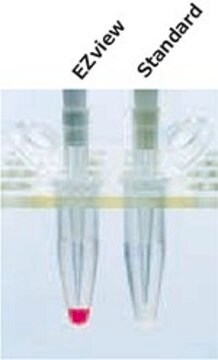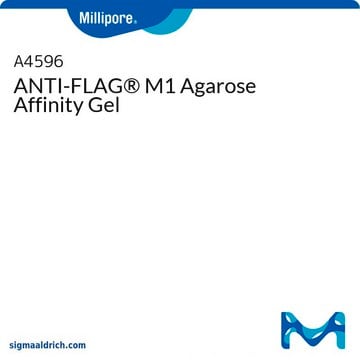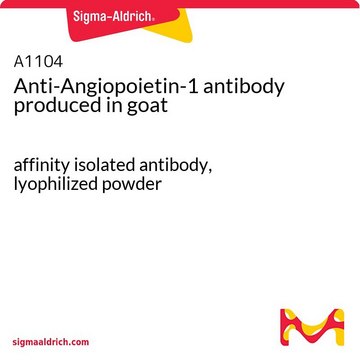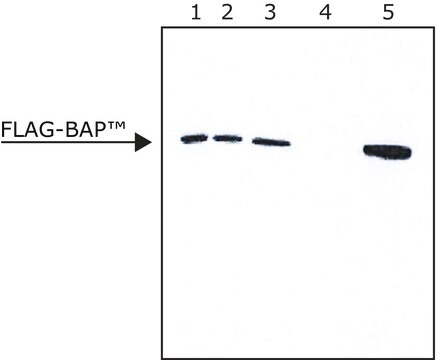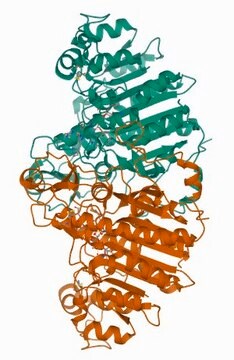A2220
ANTI-FLAG® M2-Affinitätsgel
purified immunoglobulin, buffered aqueous glycerol solution
Synonym(e):
Monoklonaler ANTI-FLAG® M2-Antikörper in Maus hergestellte Antikörper, ANTI-FLAG® M2-Agarose-Affinitätsgel, Anti-ddddk, Anti-dykddddk
About This Item
Empfohlene Produkte
Konjugat
agarose conjugate
Antikörperform
purified immunoglobulin
Antikörper-Produkttyp
primary antibodies
Klon
M2, monoclonal
Form
buffered aqueous glycerol solution
chemische Klasse(n) des Analyten
proteins
Methode(n)
affinity chromatography: suitable
immunoprecipitation (IP): suitable
Matrix
(4% agarose bead; 45-165μm bead size)
Isotyp
IgG1
Kapazität
>0.6 mg/mL, resin binding capacity (FLAG-BAP)
Versandbedingung
wet ice
Lagertemp.
−20°C
Suchen Sie nach ähnlichen Produkten? Aufrufen Leitfaden zum Produktvergleich
Allgemeine Beschreibung
Elution - FLAG® Peptid, Glycin, pH 3,5, 3x FLAG® Peptid
Immunogen
Anwendung
Weitere Produktinformationen finden Sie in unserem FLAG®-Literatur-Portal .
Physikalische Form
Sonstige Hinweise
Rechtliche Hinweise
Haftungsausschluss
Sie haben nicht das passende Produkt gefunden?
Probieren Sie unser Produkt-Auswahlhilfe. aus.
auch häufig zusammen mit diesem Produkt gekauft
Ähnliches Produkt
Lagerklassenschlüssel
10 - Combustible liquids
WGK
WGK 1
Flammpunkt (°F)
Not applicable
Flammpunkt (°C)
Not applicable
Hier finden Sie alle aktuellen Versionen:
Analysenzertifikate (COA)
Die passende Version wird nicht angezeigt?
Wenn Sie eine bestimmte Version benötigen, können Sie anhand der Lot- oder Chargennummer nach einem spezifischen Zertifikat suchen.
Besitzen Sie dieses Produkt bereits?
In der Dokumentenbibliothek finden Sie die Dokumentation zu den Produkten, die Sie kürzlich erworben haben.
Kunden haben sich ebenfalls angesehen
Artikel
The FLAG® Expression System is a proven method to express, purify and detect recombinant fusion proteins. Sigma®, the proven provider of FLAG®, now offers a magnetic bead for immunoprecipitation, protein purification, and the study of protein-protein interactions. The ANTI-FLAG® M2 Magnetic Bead is composed of murine derived, anti-FLAG® M2 monoclonal antibody attached to superparamagnetic iron impregated 4% agarose beads, with an average diameter of 50 µm. The M2 antibody is capable of binding to fusion proteins containing a FLAG peptide sequence at the N-terminus, Met-N-terminus, or C-terminus locations in mammalian, bacterial, and plant extracts.
Protokolle
Protocol for immunoprecipitation (IP) of FLAG fusion proteins using M2 monoclonal antibody 4% agarose affinity gels
Verwandter Inhalt
Protein purification techniques, reagents, and protocols for purifying recombinant proteins using methods including, ion-exchange, size-exclusion, and protein affinity chromatography.
Unser Team von Wissenschaftlern verfügt über Erfahrung in allen Forschungsbereichen einschließlich Life Science, Materialwissenschaften, chemischer Synthese, Chromatographie, Analytik und vielen mehr..
Setzen Sie sich mit dem technischen Dienst in Verbindung.


